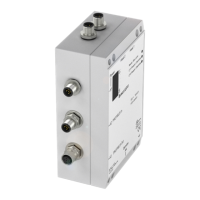13
13
english
Setting compatibility
Slide switch S1 is used to set compatibility with the BIS C-602 and BIS C-622 processors.
If the BIS C-60_2 processor is set to be compatible with the BIS C-602 or BIS C-622, all set-
tings for data exchange must be made as described in the sections on parametering, function
description, protocol sequence and LED display in the user’s manual for the BIS C-6_2 proces-
sor! This user’s manual can be mailed on request, or you may download it from the Internet at
www.balluff.de.
Slide switch S1
(with cover removed)
➪
no yes
Key: no = switch left
yes = switch right
In the illustration compatibility with the BIS C-6_2 is not set.
To open the cover of the BIS C-6002 processor, see
58,
and for BIS C-6022 see
76.
Slide switch S1
8 compatible with
yes BIS C-6_2
no BIS C-60_2
☞
Compatibility with BIS C-6_2 processor
C60_2-019_818217_0806-e.p65
14
english14
Function Description
Communication with the processor
Communication between the host system and the processor takes place using a fixed proto-
col sequence. Data integrity from the control to the processor and vice-versa is indicated by a
control bit. This bit is used to implement a handshake between the control and the processor.
Following is a simplified representation of the sequence of a job sent from the control to the
processor:
1. The control sends a command designator to the processor together with the associated
command parameters and sets a bit (AV bit). This bit indicates to the processor that the
transmitted data are valid and that the job is now beginning.
2. The processor takes the job and sets a bit (AA bit), which indicates this to the control.
3. If an additional exchange of data between the control and the processor is required to
carry out the job, each uses a bit (TI bit and TO bit) to indicate that the control / processor
is now ready for additional data exchange or has accepted the received data.
4. Once the processor has carried out the job correctly, it sets a bit (AE bit).
5. Once the control has accepted all the important data, it indicates this to the processor by
resetting the bit that was set at the beginning (AV bit).
6. The processor now in turn sets all the control bits that were set during the sequence
(AA bit, AE bit) and is ready for the next job.
Please see also
29...35 and the
examples on
36...53.
Basic Procedure

